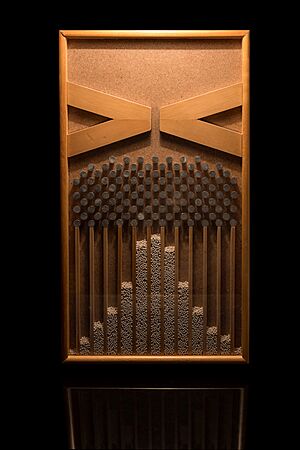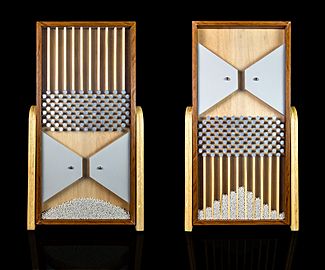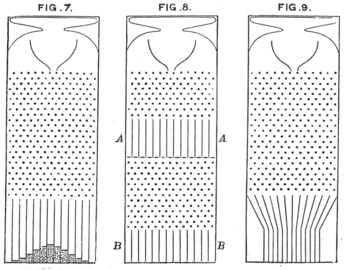Galton board facts for kids
The Galton board, also known as the Galton box or bean machine, is a cool device invented by Sir Francis Galton. It helps us see how random things can create a very clear pattern. It shows how many small, random choices can lead to a predictable shape, like a bell curve. This idea is part of something called the central limit theorem.
Contents
What is a Galton Board?
A Galton board is a tall, flat board with many rows of small pegs inside. Imagine dropping tiny beads from the very top. As each bead falls, it hits the pegs. Every time it hits a peg, it can bounce either left or right. It's like flipping a coin at each peg!
At the bottom of the board, there are many bins. As more and more beads fall, they start to pile up in these bins. What's amazing is that the beads don't just spread out randomly. Instead, they form a shape that looks like a bell! This shape is called a bell curve. The most beads land in the middle bins, and fewer beads land in the bins on the sides.
Where Can You See a Galton Board?
You can find large, working models of the Galton board in science museums. For example, Charles and Ray Eames created some for the Mathematica: A World of Numbers... and Beyond exhibits. You can see these at the Boston Museum of Science and the New York Hall of Science. There's also one at the Henry Ford Museum.
Different Kinds of Galton Boards
Most Galton boards create a bell curve. But you can change the shape of the pegs or make them lean one way. This can create different patterns in the bins. For example, some boards can show a "log-normal distribution." This pattern is common in nature, like how sizes of living things are spread out.
How Do the Beads Spread Out?
When a bead falls, it bounces left or right at each peg. If a bead bounces right a certain number of times, it ends up in a specific bin. The more rows of pegs there are, the more chances a bead has to bounce.
If you drop many beads, the way they pile up in the bins will look like a bell curve. This happens because of the central limit theorem. This theorem basically says that if you add up many small, random events, the total result will often look like a normal distribution (a bell curve). So, even though each bead's path is random, the overall pattern of many beads is very predictable!
Examples
History of the Galton Board
Sir Francis Galton invented this board. He was amazed by how a clear, orderly bell curve could appear from the seemingly random bounces of the beads. He wrote about this in his book Natural Inheritance in 1889.
He said it was incredible to see such "cosmic order" emerge from "apparent chaos." He felt that this "Law of Frequency of Error" (another name for the normal distribution) was like a powerful, hidden rule that controls things even in the wildest confusion. The more random elements there are, the more perfect this pattern becomes.
Games Like the Galton Board
The idea of objects bouncing off pegs is used in many fun games! Here are a few:
- Bagatelle
- Pachinko
- Payazzo
- Peggle
- Pinball
- Plinko
- The Wall (a game show)
See also
 In Spanish: Máquina de Galton para niños
In Spanish: Máquina de Galton para niños






